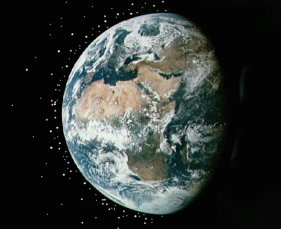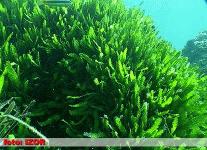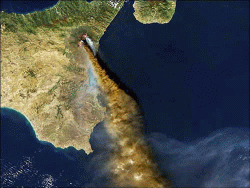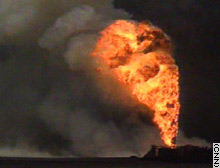The many facets of pollution
Broadly speaking, the term "pollution![]() " may be
used in several circumstances, but invariably it refers to the worsening of some
aspects of our environment, from our habitat to interpersonal relationships.
" may be
used in several circumstances, but invariably it refers to the worsening of some
aspects of our environment, from our habitat to interpersonal relationships.
 |
|
| Fig 1: After 45 years of space
exploration, near-Earth space is littered with more than 7,000 man-made
objects, or mission-related debris, which move at speeds of about 28,000
km/h. This "space debris" now presents a
serious hazard to satellites. (Credit: ARES NASA/Johonson Space Center) |
Pollution can refer to the falsification of evidence in a trial to hamper the identification of penal responsibility. The same term may refer both to the decline of collective behaviour in following dubious and illegal social rules and, from an aesthetic point of view, to landscape degradation from landfills, illegal garbage dumping, or illegal urbanization. From a physical point of view, we can mention acoustic pollution in industrial, urban or natural settings, thermal pollution (when, for example, the temperature of a receiving body of surface water increases due to a discharge into it), and rubbish tips or auto junkyards are said to constitute aesthetic or visual pollution.
Living organisms can also be
defined as pollutants, when a non-indigenous species
(plant or animal) enters a habitat and
modifies the existing equilibrium among the organisms of the affected ecosystem![]() (sea, lake, river).
(sea, lake, river).
Non-indigenous, including transgenic species (GMOs), may bring about a
particular version of pollution in the vegetal kingdom: so-called genetic pollution. This term refers to the
uncontrolled diffusion of genes (or transgenes) into genomes of plants of the
same type or even unrelated species where such genes are not present in nature.
For example, a grass modified to resist herbicides could pollinate conventional
grass many miles away, creating weeds immune to the most widely used
weed-killer, with obvious consequences for crops. Genetic pollution is at the
basis of the debate on the use of GMOs in
agriculture.
In a stricter
sense, the term pollution is commonly referred to
the release into the environment of man-made or
natural chemicals (pollutants![]() )
capable of altering
it considerably from a physical, chemical, biological, and ecological point of
view.
)
capable of altering
it considerably from a physical, chemical, biological, and ecological point of
view.
Pollution may
derive from natural events (forest fires, volcanic eruptions,
algal blooms![]() and
anoxic conditions
and
anoxic conditions![]() in coastal systems, etc.), or from anthropic sources: war (e.g.
use of depleted uranium weapons), transport
(oil spills into the sea from tanker
accidents, etc.), use of obsolete industrial technology (e.g. environmental
problems caused by the use of natural resources beyond the regenerative capacity
at source and/or when waste is overproduced or inadequately
treated).
in coastal systems, etc.), or from anthropic sources: war (e.g.
use of depleted uranium weapons), transport
(oil spills into the sea from tanker
accidents, etc.), use of obsolete industrial technology (e.g. environmental
problems caused by the use of natural resources beyond the regenerative capacity
at source and/or when waste is overproduced or inadequately
treated).
 |
Fig. 2: Caulerpa taxifolia: in the 1980s this alien
alga invaded the Northern Tyrrhenian Sea after an accidental
release into the sea from the Montecarlo aquarium. It was recently
observed along Croatian coasts, probably
transported there by
ships' ballast waters.
(Credit: IZOR ( Institute of Oceanography and fisheries)) |
|
Fig. 3:
Satellite picture of Etna's plume
during the eruption of July 2002. Along its
path, volcanic ash causes serious damage not only to people's
health but also to road and air traffic. |
 |
|
|
Fig. 4:
In the waning days of the First Gulf War in 1991, Saddam Hussein blew up
hundreds of wells in the Kuwaiti oil fields. More than 1 billion barrels of oil went up in flames, engulfing a huge
area in thick poisonous smoke. |
The Webweavers: Last modified Tue, 20 Jul 2005 10:09:35 GMT
